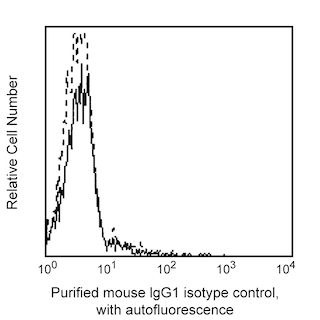Old Browser
This page has been recently translated and is available in French now.
Looks like you're visiting us from {countryName}.
Would you like to stay on the current country site or be switched to your country?



Profile of peripheral blood lymphocytes analyzed by flow cytometry.


BD Pharmingen™ Purified Mouse Anti-Human CD147

Regulatory Status Legend
Any use of products other than the permitted use without the express written authorization of Becton, Dickinson and Company is strictly prohibited.
Preparation And Storage
Product Notices
- Please refer to www.bdbiosciences.com/us/s/resources for technical protocols.
- Since applications vary, each investigator should titrate the reagent to obtain optimal results.
- Caution: Sodium azide yields highly toxic hydrazoic acid under acidic conditions. Dilute azide compounds in running water before discarding to avoid accumulation of potentially explosive deposits in plumbing.
Companion Products

.png?imwidth=320)
The HIM6 monoclonal antibody specifically binds to CD147 which is encoded by BSG. CD147 is a type I transmembrane glycoprotein (30-50 kDa) of the immunoglobulin super-gene family. Neurothelin, a blood-brain barrier-specific molecule, was clustered as CD147 in the Sixth Human Leukocyte Differentiation Antigen (HLDA) workshop. It bears homology with mouse gp42 or basigin, human "M6" or "EMMPRIN", rat OX-47 or CD-9, and avian HT7 or 5A11. CD147 is also known as Tumor cell-derived collagenase stimulatory factor (TCSF). CD147 is a molecule that is broadly expressed on cells of hematopoietic and non-hematopoietic origin. Its expression on specific cell types may be regulated by cytokines. CD147 plays a role in embryonal blood-brain barrier development and a role in integrin-mediated adhesion in brain endothelia.
Development References (5)
-
Fadool JM, Linser PJ. Evidence for the formation of multimeric forms of the 5A11/HT7 antigen. Biochem Biophys Res Commun. 1996; 229(1):280-286. (Biology). View Reference
-
Ikeda E, Flamme I, Risau W. Developing brain cells produce factors capable of inducing the HT7 antigen, a blood-brain barrier-specific molecule, in chick endothelial cells. Neurosci Lett. 1996; 209(3):149-152. (Biology). View Reference
-
Schuster VL, Lu R, Kanai N, et al. Cloning of the rabbit homologue of mouse 'basigin' and rat 'OX-47': kidney cell type-specific expression, and regulation in collecting duct cells. Biochim Biophys Acta. 1996; 1311(1):13-19. (Biology). View Reference
-
Stockinger H, Ebel T, Hansmann C, et al.. EC16 CD147 (neurothelin/basigin) Workshop Panel Report. In: Kishimoto T. Tadamitsu Kishimoto .. et al., ed. Leucocyte typing VI : white cell differentiation antigens : proceedings of the sixth international workshop and conference held in Kobe, Japan, 10-14 November 1996. New York: Garland Pub.; 1997:760-763.
-
Sudou A, Ozawa M, Muramatsu T. Lewis X structure increases cell substratum adhesion in L cells. J Biochem (Tokyo). 1995; 117(2):271-275. (Biology). View Reference
Please refer to Support Documents for Quality Certificates
Global - Refer to manufacturer's instructions for use and related User Manuals and Technical data sheets before using this products as described
Comparisons, where applicable, are made against older BD Technology, manual methods or are general performance claims. Comparisons are not made against non-BD technologies, unless otherwise noted.
For Research Use Only. Not for use in diagnostic or therapeutic procedures.
Report a Site Issue
This form is intended to help us improve our website experience. For other support, please visit our Contact Us page.